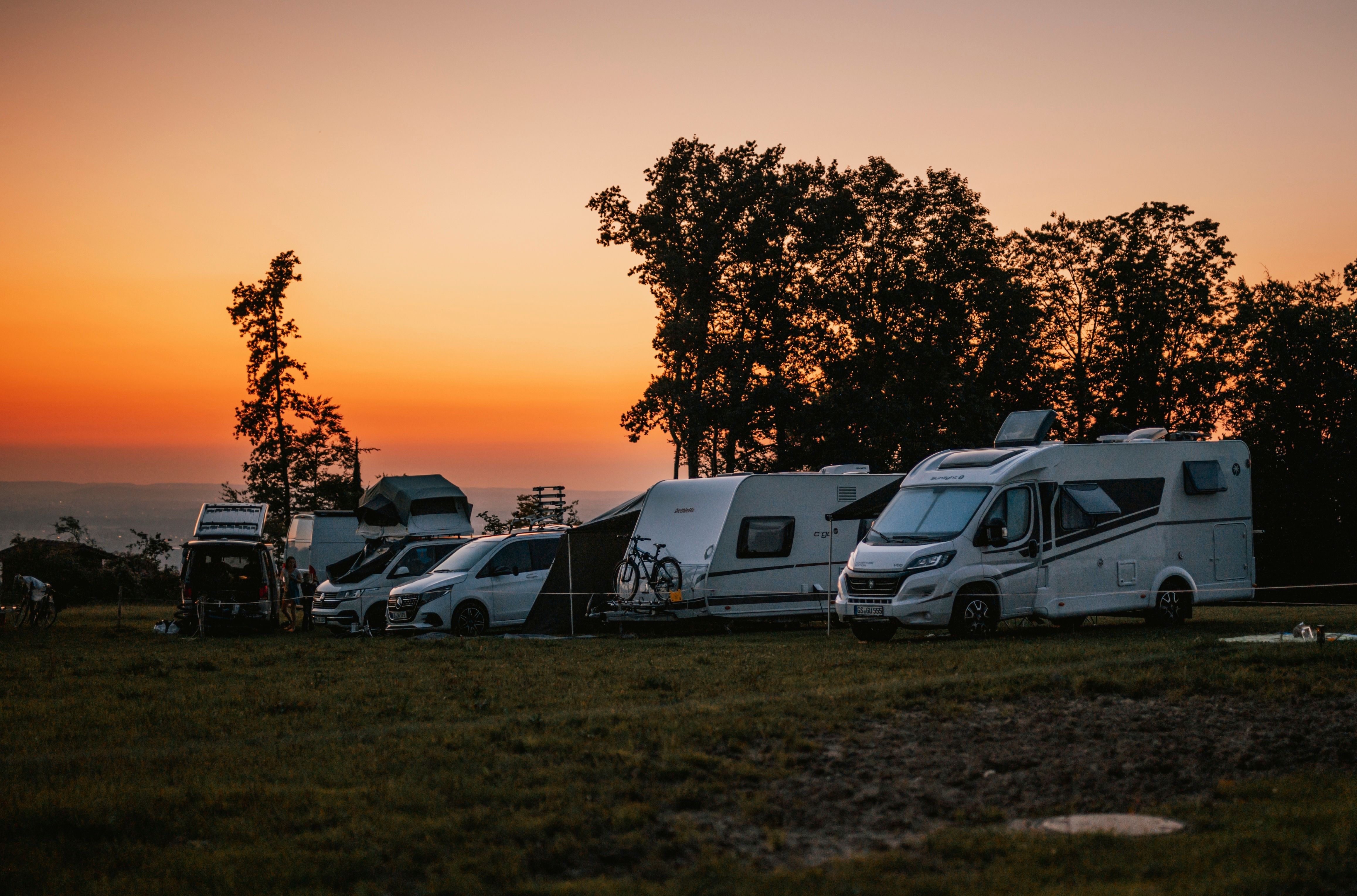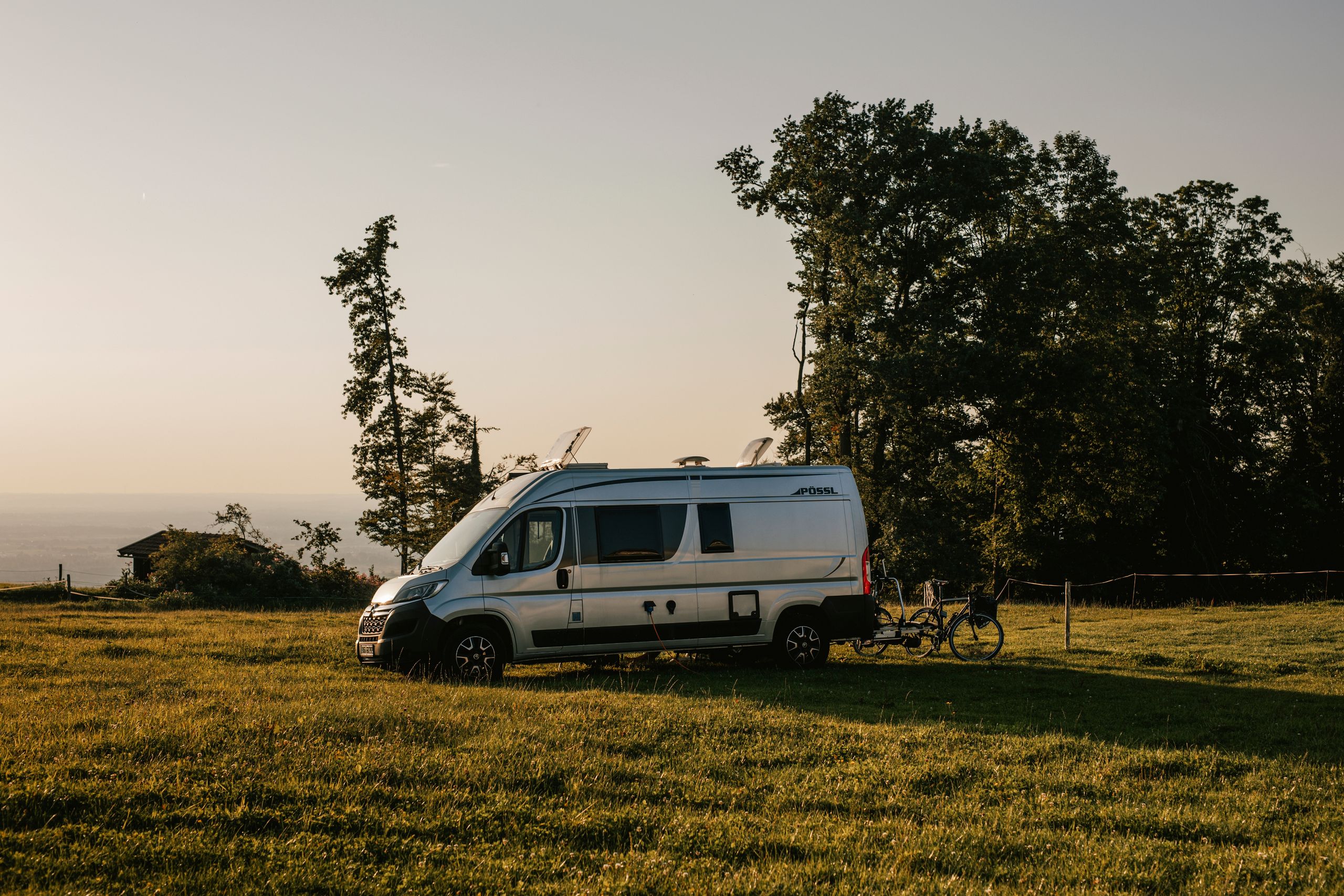Motorhome driving license: B, C1 or C1E - what you really need
from hinterland.camp
Which driving license do you need for a motorhome - is class B sufficient or is a C1 driving license mandatory? Here you can find out which rules apply, when the C1 becomes interesting and what advantages the C1E driving license can also offer.

Get in, start the engine and off you go to freedom - your home? Always with you! Owning your own motorhome offers the opportunity to live somewhere new every day, discover countless places and not have to sacrifice comfort. But this is where the question often arises: Am I even allowed to drive my dream motorhome? This is because not every model is covered by the normal driving license. While smaller campers can be driven without any problems with a class B license, you will quickly need a C1 license for larger vehicles.
If you are considering a C1 driving license anyway, it may even be worth getting a C1E driving license - this will be particularly practical if you want to take trailers or additional equipment with you on your travels. In this article, you can find out which options and rules apply to you and how costly and time-consuming the upgrade from B to C1 or even C1E is.
Contents:
- Difference between motorhome driving license class B and C1
- Vehicles up to 3.5 t: Class B
- Vehicles up to 7.5 t: C1 driving license
- Special feature: Old driving licenses (before 1999) and transitional regulations
- The C1 driving license for motorhomes - do you really need it?
- Flexibility & mobility
- Comfort & equipment
- Long-term planning
- Requirements for the motorhome driving license
- Minimum age & professional exemptions
- Medical certificates & first aid course
- Procedure & content of the training
- Theory lessons
- Practice
- Exams
- Costs: Motorhome driving license & C1
- Why it almost always makes sense to take the C1E
- Driving with C1 - does that automatically mean B?
- B or C1 - what does it cost you?
- Advantages & disadvantages of the C1 driving license
- Abroad & motorhome driving license
- Driving abroad with category B
- Validity of the C1 driving license in Europe
- Weight restrictions & toll systems
- Common misconceptions about motorhome driving licenses
- “With category B, I can drive any motorhome”
- Unladen weight vs. permissible total weight
- Difference between car & motorhome
- FAQ - Motorhome & C1 driving license
Difference between motorhome driving license class B and C1
With class B, you are on the safe side with smaller campers up to 3.5 tons gross vehicle weight. The gross vehicle weight rating is the maximum weight that the vehicle may have including driver, passengers, luggage and special equipment. It is therefore not the unladen weight of the motorhome, but the absolute upper limit that you are allowed to bring on the scales. Vehicles up to this limit can be driven with a normal B driving license - ideal for vans and panel vans that are easy to manoeuvre and are well suited for short or flexible tours.
For larger vehicles up to 7.5 tons total weight, you need a C1 driving license. This opens up more storage space, larger sleeping areas and generally more comfort on longer trips. Especially for fully equipped motorhomes or trips with several people, the C1 is often needed sooner than you might expect.
Special feature: old driving licenses (before 1999) and transitional regulations
An exciting point that many people often overlook: Anyone who obtained their driver's license before 1999 benefits from transitional regulations. This means that some drivers are still allowed to drive vehicles that actually exceed the C1 limit without having to obtain a C1 driving license. This applies to motorhomes up to 7.5 tons gross vehicle weight. Driving licenses issued from 1999 onwards are no longer subject to these special rights , so anyone with an older driving license may drive larger campers under these conditions - without a C1 driving license.
The C1 driving license for motorhomes - do you really need it?
Whether you need a C1 driving license depends primarily on what requirements you have for your motorhome and how you want to travel. To make the decision easier, you can ask yourself the following questions:
How important is flexibility and mobility to you?
With a smaller van, you are particularly maneuverable: narrow streets in old towns, winding mountain roads in the Alps or hairpin bends in remote villages in Italy and France are no problem. A larger motorhome, on the other hand, often restricts the choice of route - parking lots, narrow roads or tunnels can quickly become an obstacle.
How important is comfort to you?
Are you planning to have your own shower, a large bed and plenty of storage space for luggage, bikes or surfing equipment on board? Then a larger model is often more practical. The more equipment you want to install - water tanks, solar panels, batteries and furniture - the faster the permissible total weight approaches the 3.5-ton limit, above which the normal class B driving license is no longer sufficient.
How long-term are you planning your motorhome?
Do you only want a temporary vehicle for weekend trips or are you planning to extend the motorhome in the long term and use it for longer trips? If you opt for C1 or C1E at an early stage, you will remain flexible later on - without the need for subsequent upgrades or new tests. These considerations will give you a clear picture of which vehicle size and therefore which driving license makes sense for you.
Requirements for the motorhome driving license
Anyone wishing to obtain a C1 driving license for motorhomes must meet a number of requirements. In principle, the minimum age for obtaining a new driving license is 21. However, there is one important exception: if you already have a category B license, you can obtain a C1 from the age of 18¨NBSP;if the vehicle is used for professional purposes or is part of a vocational training course. In this case, special conditions apply to ensure that younger drivers have sufficient experience and responsibility.
In addition, medical evidence is mandatory: a current eye test and a medical examination confirming fitness to drive. You must also complete a first aid course to prove that you can act in an emergency.
Procedure & contents of the training
Training for a C1 driving license differs significantly from a normal driving license in terms of content. However, the structure is very similar - you can expect a theoretical and a practical part - both in the training and in the exam.
Theory lessons:
Here you will learn everything you need to know to drive larger motorhomes safely. This includes traffic rules specifically for heavy vehicles, load securing, driving physics with higher weights, braking distances and special features when overtaking or cornering. Topics such as environmental and toll regulations for heavy vehicles are also covered.
Practice:
In the practical part, you finally sit behind the wheel of your future motorhome - or an appropriate practice vehicle. You will practice driving with greater weight and longer vehicle lengths, parking, maneuvering, reversing and maneuvering on narrow roads. You will also practise correct loading so that you do not exceed the permitted weights and are safe on the road.
Exams:
At the end, you will take the theory test, which contains similar questions to those on the B driving license, but adapted to heavy vehicles. This is followed by the practical test, in which you demonstrate under supervision that you can safely drive your motorhome. As soon as you pass both tests, you can officially drive the larger vehicles between 3.5 and 7.5 tons - and with the C1E you can even take trailers with you.
Costs: Motorhome driving license & C1
The prices for the C1 driving license can vary greatly, but are generally between €1,500 and €3,000. What does that depend on? Primarily on your region, the driving school in question and the number of driving lessons you actually need. If you already have experience with larger vehicles, you can often manage with fewer lessons - beginners need to plan a little more.
There are also extra costs: the medical check, eye test and issuing of driving license documents are mandatory and usually cost a few hundred euros.
If you take the C1E driving license directly, you also have to plan for the practice of driving with a trailer - this means additional driving lessons and examination fees.
Why it almost always makes sense to take the C1E
If you are already taking the C1 driving license anyway, it is almost always worth taking the C1E straight away. The reason: the costs and time involved only increase slightly. While the C1 typically costs between €1,500 and €3,000, the C1E often only costs an additional €200 to €400 - depending on the driving school and the number of exams.
The difference in terms of time is also manageable: usually only one or two additional practical units are required, as theory and basic driving training are already included in the C1. So if you are already at the driving school anyway, you can take the opportunity to take everything with you straight away and save yourself additional work later on.
This is particularly worthwhile if you are planning to attach a trailer, bike rack or additional equipment behind your motorhome - this way you are flexible right from the start and don't have to do it again later.
Driving with C1 - does that automatically mean B?
A major advantage of obtaining a C1 driving license is that it automatically entitles you to drive category B vehicles. This means that you don't have to get a normal car driver's license first if you pass the C1. With the ascending driving license category, you can therefore drive motorhomes between 3.5 and 7.5 tons as well as normal cars up to 3.5 tons, as is usual with category B. This is a clear advantage for anyone who wants to remain flexible in the long term - you save time, bureaucratic effort and money if you are over 21 years old and have not yet obtained a B driving license.
B or C1 - which costs you what?
Here you can directly compare the typical costs of the two driving license classes. For a B driving license, the total cost is usually between €1,200 and €2,000, depending on the driving school, number of exams and region. The C1 driving license usually costs between €1,500 and €3,000, including practical lessons for larger vehicles, exams and any necessary medical examinations or eye tests.
Advantages & disadvantages of the C1 driving license
Advantages: With a C1 driving license, you have significantly more options when choosing your motorhome. You can choose models that offer more comfort - larger beds, spacious kitchens, a proper shower or more storage space for equipment. At the same time, you enjoy more freedom: longer trips, additional passengers and even trailers are no problem if you take the C1E straight away.
Disadvantages: There are also a few restrictions. The training and test cost more than for category B, and the vehicles themselves are larger and less maneuverable - tight parking spaces or winding country roads are more challenging. In addition, stricter regulations apply to motorhomes over 3.5 tons: speed limits of usually 80 km/h on country roads and 100 km/h on freeways as well as higher insurance premiums because the risk of accidents is assessed higher.
Abroad & motorhome driving license
If you want to take your motorhome abroad, it's worth knowing the rules beforehand.
Driving abroad with a class B license. In most European countries, you are allowed to drive vehicles up to 3.5 tons with a normal car driver's license - so this also applies to smaller motorhomes. However, pay attention to local special regulations, such as for tunnels, bridges or toll roads.
Validity of the C1 driving license in Europe. The C1 is recognized in all EU countries. If you drive larger motorhomes between 3.5 and 7.5 tons, you are on the safe side. C1E, i.e. including trailers, is also accepted in most countries - but it is still worth taking a quick look at the respective traffic regulations.
Weight restrictions & toll systems. Many countries have special regulations for vehicles over 3.5 tons. This applies to speed limits, parking facilities, access restrictions and toll systems. You should be aware of these limits, especially when vacationing in mountainous regions or on narrow roads, to avoid unpleasant surprises.
Common mistakes with motorhome driving licenses
Now that we've clarified the most important points about driving license classes, weight and regulations, it's time to correct some common misconceptions.
"With a class B license, I can drive any motorhome" - not true. Many people think that a normal car driver's license is enough, regardless of the model. The fact is: For motorhomes over 3.5 tons, you need a C1 or even C1E.
Unladen weight vs. permissible total weight. The unladen weight is the weight of the vehicle without occupants, luggage or extras. The decisive factor for the driving license category, however, is the gross vehicle weight rating - i.e. everything you are actually taking with you. Especially when converting a van, you should calculate in advance how much water tanks, batteries, furniture and equipment weigh together so as not to exceed the limit.
Difference between car and motorhome. Motorhomes are not just "big cars". They have different driving characteristics, longer braking distances, special speed limits and stricter insurance and load securing regulations. If you are only used to driving a car, you should be aware of these differences.
Happy road trip!

In a nutshell: Frequently asked questions about the motorhome & C1 driving license
Which driving license do I need for a motorhome over 3.5 tons?
Motorhomes between 3.5 and 7.5 t require a C1 driver's license. If you also want to tow a trailer, C1E is required. Vehicles up to 3.5 t can be driven with category B.
C1 driving license for motorhomes - is it really worth it?
Yes, anyone planning more comfort, storage space or longer journeys will benefit from C1. As C1 and C1E hardly take up any more time and cost, it is often worth doing both classes straight away.
How long is the C1 driving license valid for?
C1 must be renewed every 5 years - this requires a current medical certificate and an eye test.
Can I drive large motorhomes with an old driver's license?
Driving licenses issued before 1999 have transitional regulations. Depending on the permissible total weight, driving large motorhomes is still permitted in some cases without immediately obtaining a C1.
Can I do C1 retroactively even if I've had class B for a long time?
Yes, that's no problem. You must complete the theory and practical lessons as well as the exams, regardless of how long you have been driving.
What does the C1 driving license for motorhomes really cost?
The total costs are between €1,500 and €3,000, depending on the driving school, region, number of exams and additional costs such as doctor, eye test or documents.
Can I tow a motorhome trailer with a C1 driving license?
Only with C1E. Those who take C1E directly save time and money because the additional test requires minimal extra effort.
Is the C1 driving license also valid for motorhomes abroad?
Yes, C1 is recognized within the EU. However, please note special regulations such as weight restrictions, speed limits or toll systems in the respective country.
What are the differences between unladen weight and permissible total weight?
Unladen weight describes the vehicle weight without load, passengers or water. Permissible total weight includes everything - camping equipment, water tanks, luggage and passengers. Only the latter counts for the driving license class.
How does the conversion of a van affect the overall weight?
Every installation - battery, water tank, furniture, refrigerator - adds weight. Plan carefully beforehand so as not to exceed the 3.5-ton limit for class B.
Can I still use my old driver's license from before 1999 for heavy motorhomes?
Yes, in part. Transitional regulations still allow certain driving licenses to drive large motorhomes. Check the permitted weight class of your old driving license carefully.
Insider tips, giveaways and more
Want more insider tips like this? No problem! In our newsletter we keep you up to date on insider tip camps and cabins, competitions and much more. Become part of the Hinterland community, we look forward to hearing from you!


